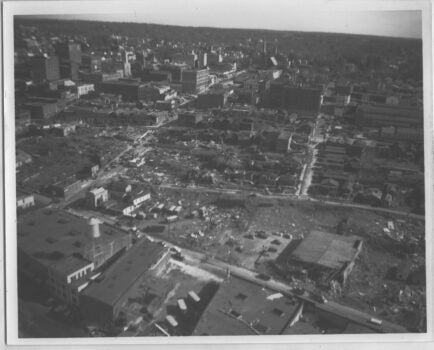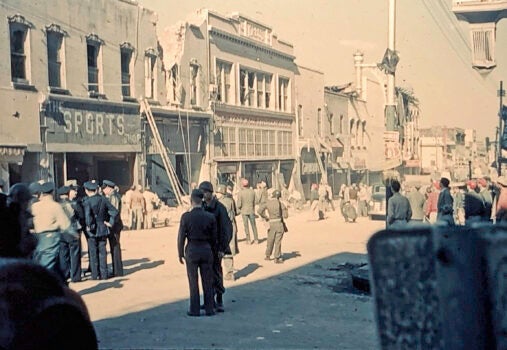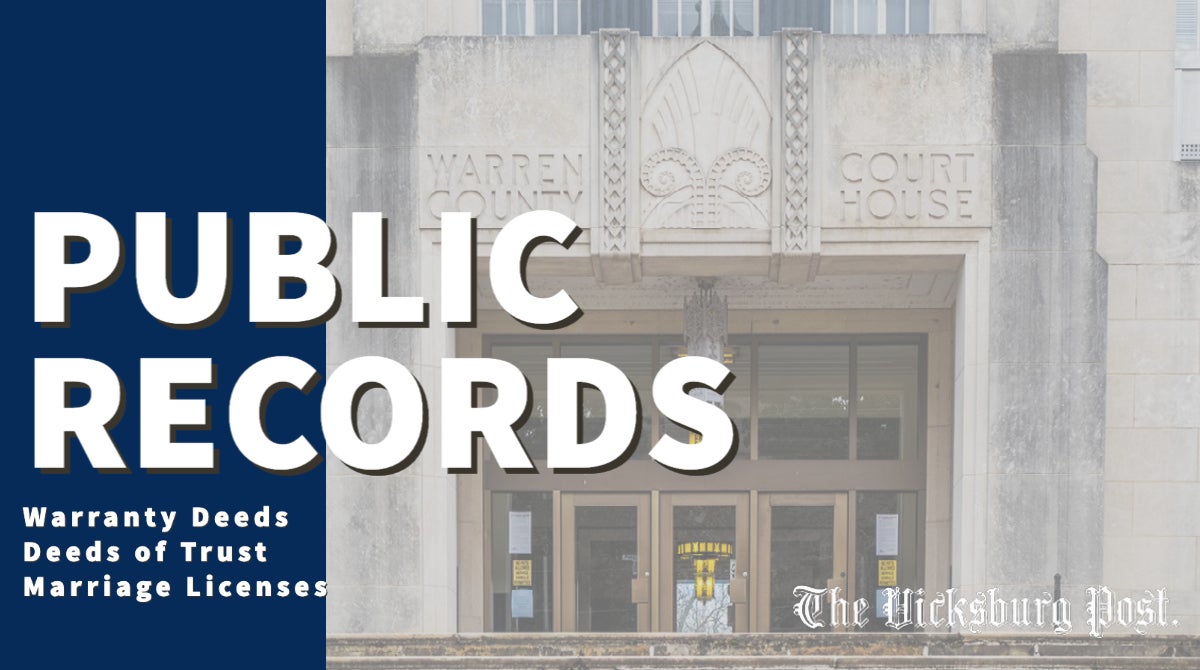Weather Service storm summary tells history of tornado
Published 10:44 am Saturday, December 2, 2023
All it took was nine minutes to transform Vicksburg into a disaster area.
The 1953 Vicksburg tornado was probably the worst disaster to strike Vicksburg since the siege, causing severe damage to homes and businesses and causing tragedy for many families and its history is best told by a National Weather Service summary of the tornado written after the storm and update.
From the time it touched down about 5:31 p.m. in eastern Madison Parish west of the Mississippi River until it ended about 5:40 p.m. north-northeast of the city, the Dec. 5, 1953, the Vicksburg tornado traveled 7 miles, cut a path 500 yards wide, killed 270 people, injured 38, left 1,200 people homeless and caused $25 million in damage (more than $288 million in today’s money).
It was one of five F5/EF5 tornadoes to hit the U.S. in 1953.
But on that Saturday, the potential of severe weather was not on the minds of Vicksburg residents as they went through their weekend activities.
According to the Weather Service summary of the storm, weather conditions were unseasonably warm for that time of year, with temperatures beginning the day in the lower 50s – about 10 to 15 degrees above normal.
Clouds filled most of the sky, but there were occasional peeks of sun and breezy, occasionally gusty southeasterly wind. Sustained winds were measured as high as 17 miles per hour before noon at the U.S. Weather Bureau office in downtown Vicksburg.
Vicksburg residents were out enjoying the relatively warm early December weather, taking advantage of the warm temperature for Christmas shopping. The streets were decorated for the season. While occasional showers wet the area, they weren’t enough to stop a planned afternoon parade or a charity football game to help with medical bills for Leo Puckett, a Jett High School football player who sustained a spinal injury during a September football game, leaving him paralyzed.
According to the Weather Service summary, a warm front lifted northward across the region during the day with temperatures rising to 72 degrees by mid-afternoon. The dew point reading at the Vicksburg Municipal Airport rose from the 40s that morning to almost 70 behind the warm front.
“In the increasingly moist and unstable air mass south of the front, thunderstorms developed across central Louisiana during the day, moving northeastward. In the upper atmosphere, wind shear was also strengthening, making conditions more favorable for tornadoes,” according to the summary. At 1:30 p.m., the summary indicated the U.S. Weather Bureau’s Severe Local Storms Unit issued a severe weather bulletin indicating that “tornado-producing conditions” would exist in an area between Tyler, Texas, Little Rock, Arkansas, Clarksdale and Monroe, Louisiana.
About 4 p.m. a tornado developed north of Ruston, Louisiana. and tracked 8 miles through the town of Spearsville, injuring 16. A another tornado developed farther east about an hour later leaving a 60-mile long path of damage that extended from northeast of Monroe near Spencer, Louisiana, and into southeast Arkansas.
At 5:30 p.m., a storm moving northeastward across eastern Madison Parish produced a tornado just west of the Mississippi River.
But tornados weren’t supposed to occur in Vicksburg. “They had always said Vicksburg would never have a tornado because of the river,” longtime Vicksburg resident Marie Renaud recalled for the 60th anniversary of the tornado.
“Unfortunately, many Vicksburg residents found out the hard way that this belief was merely a falsehood,” the newspaper summary continued. “The tornado crossed over the Mississippi River bridge, moving across the river to the southern tip of DeSoto Island, where it downed several trees. As the tornado crossed the Yazoo Diversion Canal, it took one of its first victims, a fisherman whose body was never found.”
After crossing the Mississippi River, the tornado became stronger as it moved through the industrial area along Levee Street southwest of downtown. “Significant damage occurred along the Vicksburg railroad and at businesses such as the Union Compress and Warehouse Company, the Valley Gin, the Levee Street Foundry and Machine Works, the Vicksburg Transfer Company, and the P.P. Williams Company,” according to the NWS summary. “The tornado then began to move uphill from the river toward the downtown area, demolishing several small shacks as it moved across Pearl Street, Veto Street and Mulberry Street and into the central business district.”
The tornado caught residents in the downtown area off guard as it hit the city’s center. Many heard the storm coming moments before it arrived, and made a last-ditch attempt to run into the back of buildings or basements for safety.
According to the summary, as the tornado moved across South Street, one eyewitness said the Farmer’s Tractor Supply Company “just exploded right in front of my face.” The company’s owner lost his life. In the same block, the summary continued, several businesses were hit along Washington Street, most notably Mississippi Hardware and Ben Warren’s Clothing Store.
“Those two buildings almost completely collapsed, trapping several individuals including many who were seeking shelter in the basement at Mississippi Hardware. Two lives were lost at Ben Warren’s Clothing Store, including a daughter of the owner.
The twister caused more severe damage as it crossed Crawford Street, hitting numerous businesses along Washington Street, including the Sports Shop, Palermo’s Mens Shop, and the S.H. Kress Dime Store. Two people died at Palermo’s, including a customer and the son of the owner.
A block to the east, the tornado heavily damaged St. Paul Catholic Church. The historic church building was not leveled by the tornado but the structure was later determined to be unsound and was rebuilt.
The tornado continued across Clay Street damaging First National Bank, the Jefferson Davis Hotel, the Hotel Vicksburg and caused a partial wall and roof collapse at the Strand Theatre.
Damage to another theater, however, would result in tragedy.
The Saenger Theater, located at 1209 Walnut St., was in the center of the tornado’s path. Before the tornado hit, according to the summary, the power flickered and eventually went off. Then light suddenly reappeared in the large theatrer as a wall collapsed, bringing the screen down. The ceiling collapsed, trapping several people under their seats and debris. Five children died at the theater, each under the age of 10.
According to the summary, three women were initially trapped in the destroyed theater for several hours before being rescued. Among those was Lillian Mitchell, who was at the theater with her two daughters who were killed when the theater collapsed.
Mitchell, who was seven months pregnant, was taken to the maternity ward at Mercy Hospital, where three days later she gave birth to a third daughter.
After hitting the Saenger Theater, the tornado continued north across China Street, wrecking the Keith Williams Chrysler-Plymouth dealership, then northward across Grove Street, where another fatality occurred. The storm crossed Monroe Street, clipping the Old Courthouse before hitting the Happyland Nursery, where two toddlers died. Another fatality occurred as the tornado crossed Cherry Street near the intersection with Main Street.
“At this point, the Joe Wing Sing grocery store was demolished about two blocks outside of the tornado’s main damage path at the corner of Openwood Street and Farmer Street,” the summary continued. “It is believed this may have been a satellite tornado that developed on the periphery of the main cyclone.”
Moving north, the tornado caused severe damage in a residential area on the north side of the city.
Many homes along Adams Street, Randolph Street, Fayette Street, Jefferson Street, Locust Street, and the surrounding areas were completely leveled. At least three deaths occurred in this neighborhood, including a mother and daughter. The tornado then moved into the western portion of the Vicksburg National Military Park, crossing Confederate Avenue and causing considerable damage from the Fort Hill area eastward to the observation tower that once stood on that side of the park.
“Residences were then damaged along Union Avenue, also in the park,” the summary added, continuing, “As the tornado exited the park, it moved into the Waltersville community. Along Sherman Avenue, 17 homes and a church were destroyed. A man died at this location, possibly the last life taken by the storm as it moved northward into a more rural wooded area and dissipated.”
In 1953, people didn’t have access to the different forms of media that would be available 70 years later, and news of the tornado was slow to reach others outside Vicksburg.
According to the Weather Service summary, the Jackson Weather Bureau first received word about 20 to 30 minutes after the tornado occurred. The observation form from the Hawkins Field office in Jackson reported at noted at 5:58 p.m. “State Highway Patrol reports unconfirmed tornado at Vicksburg Miss., moving NE. Damage unknown. Power out at present.”
A later MHP update at 6:10 p.m. confirmed a tornado hit Vicksburg.
In the wake of the twister, victims were trapped in several downtown buildings for hours, and some into the following day.
“Downtown Vicksburg would never look the same again,” the summary added.
“In the immediate aftermath of the tornado, emergency personnel, the Mississippi National Guard, the Red Cross, private citizens, and many others rushed to the scene of the devastation to help find survivors,” the summary continued. “Even after the tornado, winds remained gusty with occasional showers moving through the downtown area, hampering relief efforts to some extent.”
On Dec. 5, 1953, according to the summary, “There were 19 confirmed tornadoes, including a violent F4 tornado that hit the northwest side of Alexandria, La., and an even more violent F5 tornado that hit Vicksburg, Miss. In all, the tornadoes killed 49 people, injured 404 others, and caused $45,709 million ($526.7 million in 2023) in damage.








